Amazon ECS Concepts
External
Internal
Overview
Amazon Elastic Container Service (ECS) allows deploying Docker containers on a scalable cluster. Docker images to be deployed typically come from Amazon ECR.
Container
The container is based on an image, that should be chosen when creating the container.
Cluster
An Amazon ECS cluster is a regional, logical grouping of tasks and services. If the tasks or services in question use the EC2 launch type, the cluster is also a grouping of container instances. A default cluster is always available, but multiple clusters can be created in an account to keep your resources separate. A cluster cannot span more than one region.
Cluster Configuration
Cluster Name
Cluster VPC
Cluster Subnets
Cluster Operations
Task
Task Definition
A task definition is a blueprint, or a configuration, for an application, and describes one or more containers through attributes. Some attributes are configured at the task level but the majority of attributes are configured per container. It specifies the Docker image, how many containers to use for this task and the resource allocation for each container. To modify the task definition, a new revision must be created and then make the required changes to the task definition.
Task Definition Name
Network Mode
The Docker networking mode to use for the container in the task. A typical conventional value is "awsvpc".
Task Role
The task role is the IAM role that allows the containers in the task permission to call the AWS APIs that are specified in its associated policies on the IAM user's behalf. The steps necessary to create a Task Role, as well as specific individual permissions are described in detail in:
Task Execution Role
The task execution role is the IAM role that allows the containers in the task to pull container images and publish container logs to CloudWatch on the IAM user's behalf. The steps necessary to create a Task Role, as well as specific individual permissions are described in detail in:
Compatibilities
The launch type used by the task.
Task Memory
Task CPU
Task Revision
A new task revision is created when a task definition is modified.
Running Task
A running task is based on a task definition and it has an unique ID (e.g. e822d0018c324c47a2001e8ea6a76d4f). The running task has associated time statistics, such as "Created at" and "Started at". Also, stdout content generated while the task is running is available as Cluster -> <cluster-name> -> Tasks -> <task-id> -> Logs.
Stopped Task
Task Operations
Service
A service allows running and maintain a specified number (the "desired count") of simultaneous instances of a task definition in an ECS cluster.
Service Definition
Service Name
Number of Desired Tasks
Security Group
A security group is created to allow all public traffic to the service only on the container port specified. Security groups and network access can be further refined after the service creation.
Service Status
Service Type
REPLICA
Service's Task Definition
Load Balancer Type
Service Operations
Launch Type
EC2 Launch Type
The EC2 launch type allows running a containerized applications on a cluster of Amazon EC2 instances.
Fargate Launch Type
The Fargate launch type allows running a containerized application without the need to provision and manage the backend infrastructure. It only requires registering a task definition. When that is available, Fargate launches the container.
